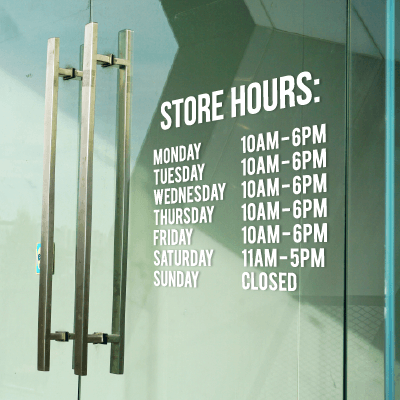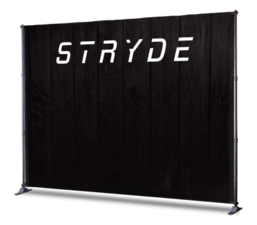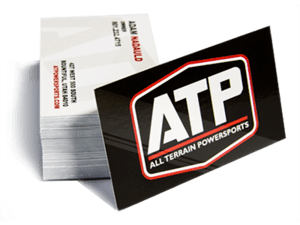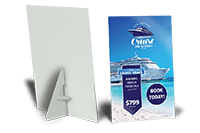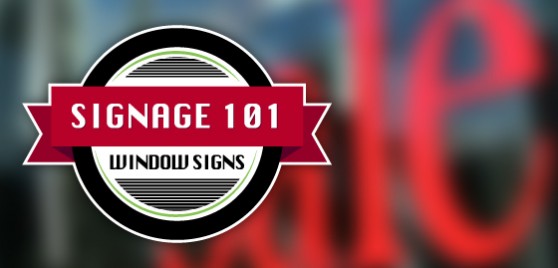
Our “Signage 101” series helps you make sense of the world of signage and all of its different options. We’ve previously put together a video on vinyl banners and talked about every last thing you’ll ever need to know about grommets. Today we’ll tackle signage options for windows.
Whether as an individual or a business owner, the odds are pretty good that the sign you’re designing or looking to buy will be placed on a window. Businesses have been using storefronts as a prime way to entice potential customers for a couple hundred years. Even inside businesses there’s ample opportunity to use the types of window signs outlined below. Meanwhile it’s not uncommon to see some kind of no soliciting sign on the windows of residential homes in an attempt to get rid of the never ending stream of pesky salesmen. So without further ado let’s look at the different types of window signs, their differences, usages and more.
Decal, Sticker or Cling?
The first distinction to make when it comes to window signs is what type of adhesive material it uses, if any. This is a common question and aspect that causes the most confusion. Their respective definitions and adhesive properties are as outlined below:
Window Stickers – A sticker is just as it sounds. A one time use material that won’t be able to be repositioned. “Stickers” in this sense are often interchanged with the word “decal” in the signage industry. So instead of looking or asking for “window stickers”, what you’re most likely looking for is a window “decal.”
Window Decals – Window decals all have some kind of adhesive backing that is stuck to a window. This can be done on the outside, the inside or even from the inside facing out (this last option is called “inside glass” and is described below). This adhesive material means that your actual window sign is “semi-permanent.” This just means that when installing the decal there will be some wiggle room to adjust it as needed but once the decal’s adhesive kicks in it will be extremely difficult to reposition. (This is just the opposite from our wall decals which are made of a lower tac adhesive material which allows the decal to be repositionable. So if you’re looking for something that can be moved around and is a non-window option then jump on over to our wall decals page.) These types of window decals come in three different types which are outlined below.
Clear Window Decal – Your decal will be clear everywhere that the design itself is not printed. These are great for storefronts and doors to allow two way visibility – assuming your design doesn’t cover the entire surface area of the actual decal. Also, make sure that any design on these types of decals has a strong contrasting color to ensure smaller decals can be seen from a distance if so desired.
Opaque Window Decal – Opaque decals obscure visibility from either side of the window. Rather than having “clear” portions of your sign, wherever the design does not cover it will be an opaque white. The best way to describe this is like a frosted window in a bathroom. While it isn’t completely blacked out the visibility through these is obscured by the opacity of the non-printed area.
Perforated Window Decal – Perforated window decals are designed to allow one-way visibility. In other words, these are signs that allow you to see from the inside of your business to the outside but not vice versa. Therefore, you can still advertise your store hours, business logo or brand, and deals while seeing out of your store. Customers approaching your store will be able to see the decals clearly but won’t be able to see inside of the store. This is achieved by printing onto a material on one side of the sign that is perforated with tiny holes. These perforations won’t affect the aesthetics of your sign while creating one-way visibility that many business owners desire.
Static Clings – Unlike a traditional sticker or window decal, static clings have no adhesive side. Rather, they attach through the static charge of the sign itself and the window. These signs are easily removed and reapplied in different situations. They are often used in such places as a sneeze guard inside a restaurant in order to advertise deals or soups of the days. Static clings can also be clear or opaque in nature.
Decals vs. Clings – Pros and Cons or Differences?
The major advantage of decals is the adhesive material which makes for a stronger and more lasting sign than a static cling. The other major difference between a cling and a decal is what was alluded to above – clings are repositionable while decals are, for the most part, not. This makes clings much easier to install and more forgiving if you need to place them differently than you originally did. This can be an important consideration depending on the ultimate use of your sign. Another difference between the two is removal of the actual sign. Decals will sometimes require a razor blade and soapy water to remove any residual adhesive just like when removing stickers. Clings simply peel away from the window leaving no trace behind and requiring no clean up.
Which One To Buy?
As detailed above both clings and decals have their pros and cons. Ultimately when you are looking for a window sign the first thing you need to determine is what will be the end use of the sign? How you are going to use the sign is going to dictate what type of sign you need to use.
If you need something that is repositionable then you need to get a cling. (The other option being a wall decal, but again, wall decals and clings are very different. Wall decals stick due to the adhesive material while clings have no adhesive.) If the sign you intend on using is more permanent or going to be used outside then a decal is usually a better choice. There are even decals for cars, as well as high adhesive exterior decals that work on the ground – just think about a pool deck that has signs on the ground with warnings about running and the slippery surface. We produce both of these types of decals as well.
The last thing to consider is the visibility needed in relation to your sign. Clear decals and static clings will have two-way visibility wherever there isn’t printed ink. Perforated decals will offer one-way visibility from the inside of your store while opaque decals will obscure visibility regardless of which side of the sign you are viewing it from. Depending on your visibility needs you’ll need to select the correct type of sign.
Where Can I Use Them?
As outlined above clings generally work better inside and on glass but can be used outside as well. They will not cling to walls (wall decals is what you want) nor to brick, metal, or other non-glass like surfaces. Decals, depending on the type, can be used on glass and glass like surfaces. They can be used both inside and outside.
Are Clings or Decals More Expensive?
Window decals of all types tend to be more expensive than static clings. In order, the most affordable decals are clear, opaque and perforated. Perforated is the most expensive due to the micro punctures that create the one way visibility. Actual pricing can be viewed on our Sign Price Calculator or by changing the “sign type” and size in our online design tool.
What Kind Of Options Do I Have For My Window Signs?
Both clings (opaque and clear) and decals (clear, opaque and perforated) come with several options. Most of these sign types have all of these options available except as noted below.
Inside Glass – Inside glass, or second surface as it is sometimes called within the signage industry, means that the static cling or window decal will be reverse printed so that the sign can be placed on the interior of the glass but face out. This is an extremely popular option for small business owners or even homeowners who wish to have an external facing sign but protect it from the elements by placing it inside. Store hours, deals and promotions, branded decals and much more can be used in this fashion. For decals this means that the design will be printed on the backside of the decal so that the front adhesive side can still be applied to the inside of the glass and face out. This means that opaque and perforated decals cannot be printed as “inside glass”. The same applies to opaque window clings. If you want an inside glass decal that looks opaque, simply use a clear decal or cling, but fill the background in with a color or graphic.
Custom With Border (Halo Cut) – Any of the cling or decal sign types can be “Custom With Border” (previously known as or sometimes called “halo cut”). This means that the sign will be cut to the shape of the actual design with a small border – typically around ¼” – left around the perimeter of the sign.
Custom (Contour Cut) – many cling or decal sign types can be custom shape (previously known as or sometimes referred to as “contour cut”). This means that the design of the sign will be cut exactly to the perimeter of the sign. The most important thing to remember here is that if your sign is all text that you actually want what is called “vinyl lettering” or “cut vinyl”. This is often seen on office windows and storefronts where individual adhesive letters are applied to display the company name or brand. We don’t currently offer this on the website but can produce it. You simply need to call us if this is what you are looking for. When it is a simple non-text design, it is cut to the exact shape without any border as the halo cut option entails.
We’ve summarized what sign type you should choose, the differences and the visibility and cut options in the graphic below. The written transcription is below the graphic.

Visibility
Opaque Window Cling and Decal – The red portion of the sign is the only portion of the graphic that is printed. The white is the default color of the material without any ink.
Perforated Window Decal – Visitors from outside would see the graphic and would not be able to see into the store (this is sometimes called one-way vision). The graphic would not be visible from inside the store but would allow people inside of the store to easily see out through the micropunctures.
Clear Window Decal – Assuming the red portion of the sign was the only color on the graphic, the rest of the sign would be transparent.
Cut Options
Custom With Border (Halo Cut)– A “Custom with Border” would mean that your red circular sale decal would have a tiny border of approximately 1/4 inch left around the perimeter of the decal.
Custom (Contour Cut) – Custom, “contour cut” would cut your red circular decal right at the border of the red circle leaving no white border.
Cut Vinyl or Vinyl Lettering – If the design weren’t circular but rather a collection of individual pieces then this would be cut vinyl or vinyl lettering. These individual pieces would be cut exactly to shape with no border and then could be applied to the appropriate surface as individual pieces rather than a single decal.
Related Articles
Difference Between Decals and Stickers – Signage 101.
Signage 101 – Inside Glass Decals.








